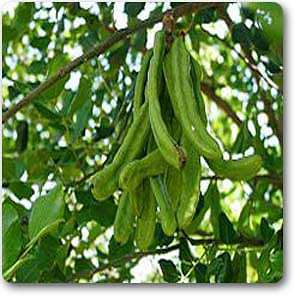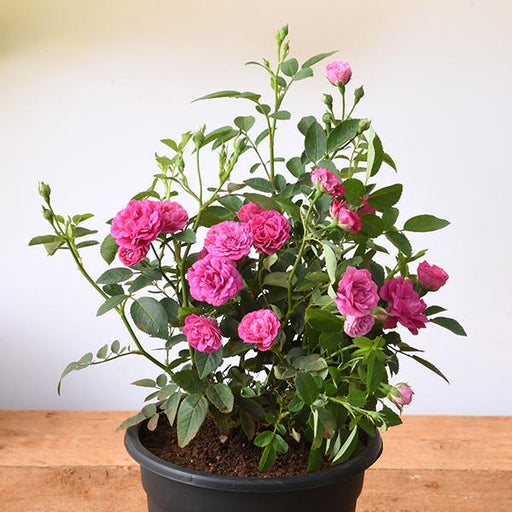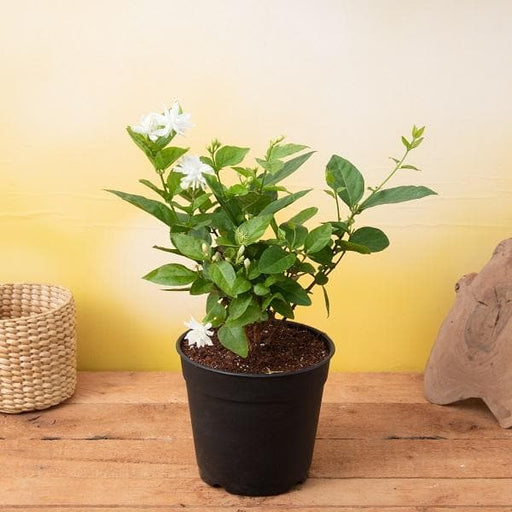
Carob - Plant
(MRP Inclusive of all taxes)
- Shipping ₹79 for entire order
- Dispatch in 7 days
- Country of origin: India

(MRP Inclusive of all taxes)
 Save 29%
Save 29%
Air Purifier Money Plant with Pot The Air Purifier Money Plant, also known as Pothos or Epipremnum aureum, is a stunning indoor plant that...
View full details
 Save up to 15%
Save up to 15%
Peace Lily, Spathiphyllum - Plant The Peace Lily, scientifically known as Spathiphyllum, is a stunning houseplant celebrated for its elegant white...
View full details
 Save 25%
Save 25%
Jasminum sambac, Mogra, Arabian Jasmine - Plant Jasminum sambac, commonly known as Mogra or Arabian Jasmine, is a fragrant flowering plant...
View full details
 Save 18%
Save 18%
Combo Constituents Includes the Parijat Tree (Night-Flowering Jasmine), a culturally significant plant with fragrant flowers. Description The Pari...
View full details
 Save 25%
Save 25%
Miniature Rose, Button Rose (Any Color) - Plant The Miniature Rose, also known as the Button Rose, is a charming and compact flowering plant that ...
View full details Save 25%
Save 25%
Damascus Rose, Scented Rose (Any Color) - Plant The Damascus Rose, also known as Rosa damascena, is a timeless symbol of beauty and romanc...
View full details
 Save 17%
Save 17%
Beautiful Fragrant Mogra, Arabian Jasmine Plant with Pot The Beautiful Fragrant Mogra, also known as Arabian Jasmine (Jasminum sambac), is...
View full details Save 15%
Save 15%
Pack of Vermicompost and Neem Cake for House Plants Transform your indoor garden with our premium Pack of Vermicompost and Neem Cake, spec...
View full details
Pack of Plant Growth and Flower Boosters Unlock the full potential of your garden with our Pack of Plant Growth and Flower Boosters! This ...
View full details Save 38%
Save 38%
Combo of Jeevamrut and Neem Raksha for Easy Growth and Protection of Houseplants Transform your indoor garden with our exclusive combo of ...
View full details Save 22%
Save 22%
Plant Nutrients Kit (Pack of 16) for a Healthy Garden Transform your garden into a lush paradise with our Plant Nutrients Kit, featuring 1...
View full details Save 16%
Save 16%
Combo of Top Plant Fertilizers Elevate your gardening game with our exclusive Combo of Top Plant Fertilizers, featuring two bags of premiu...
View full details Save 24%
Save 24%
Pack of 4 Additives to Make Soil Healthy and Nutrient Rich Transform your garden into a thriving ecosystem with our Pack of 4 Additives de...
View full details Save 30%
Save 30%
Transform your gardening experience with our premium Combo of Perlite and Vermiculite. This unique blend is designed to enhance soil aeration and ...
View full details Save 27%
Save 27%
Combo of 2 Vermicompost and Cocopeat - Enrich Your Soil Naturally! Transform your garden into a thriving ecosystem with our Combo of 2 Ver...
View full details
 Save 35%
Save 35%
Best 6 Plants for Perfect Indoor Garden Transform your living space into a lush oasis with our curated collection of the Best 6 Plants for a...
View full details
 Save up to 50%
Save up to 50%
Mini Succulent Garden Pack Transform your space with our Mini Succulent Garden Pack, featuring a delightful collection of 4 any variety beautiful s...
View full details
 Save 30%
Save 30%
5 Best Fragrant Plants Transform your garden or indoor space into a fragrant paradise with our curated selection of the 5 Best Fragrant Plants. Th...
View full details
 Save 24%
Save 24%
Set of 2 Bonsai Looking Grafted Adeniums Transform your indoor or outdoor space with our exquisite Set of 2 Bonsai Looking Grafted Adenium...
View full details Save 45%
Save 45%
Top 4 Die Hard Succulents Pack Transform your indoor or outdoor space with our Top 4 Die Hard Succulents Pack, featuring a curated selecti...
View full details
 Save 30%
Save 30%
5 Best Indoor Plants Pack Transform your living space into a lush oasis with our '5 Best Indoor Plants Pack.' This carefully curated collection fe...
View full details
 Save 25%
Save 25%
Set of 4 Evergreen Air Purifier Plant Pack Transform your indoor space into a lush, green oasis with our Set of 4 Evergreen Air Purifier Pla...
View full details| SrNo | Item Name |
|---|---|
| 1 | Carob - Plant |
The Carob tree (Ceratonia siliqua) is a remarkable leguminous plant native to the Mediterranean region. Known for its sweet, edible pods, carob is often used as a chocolate substitute, making it a popular choice for health-conscious consumers. Rich in fiber, antioxidants, and essential minerals, carob is not only a delicious treat but also a nutritious addition to your diet.
What makes carob special is its unique flavor profile and health benefits. Unlike chocolate, carob is caffeine-free and low in fat, making it an excellent alternative for those sensitive to stimulants. Its natural sweetness allows for reduced sugar in recipes, promoting healthier eating habits.
One of the standout features of the carob plant is its ability to thrive in arid conditions, making it an environmentally friendly choice for sustainable agriculture. Carob trees also improve soil quality and provide habitat for wildlife, contributing positively to their ecosystems.
Carob trees play a significant role in combating desertification and improving soil health. Their deep root systems help prevent erosion and promote water retention, making them ideal for arid regions. By choosing to grow carob, you contribute to sustainable agriculture and support biodiversity.
Carob is not just a tree; it’s a superhero in the plant kingdom! Packed with fiber, antioxidants, and a natural sweetness that makes candy bars jealous, carob is a guilt-free indulgence. It’s caffeine-free, so you can enjoy its rich, chocolatey flavor without the jitters. Plus, it’s a digestive ally, helping to keep your gut happy. Who knew a tree could be so versatile? From smoothies to baked goods, carob is the secret ingredient your recipes have been missing.
Move over cocoa powder; there’s a new kid in town! Carob powder is the earthy, sweet alternative that’s taking the culinary world by storm. With its naturally sweet flavor, it’s perfect for those who want to cut down on sugar without sacrificing taste. Sprinkle it in your oatmeal, blend it into your shakes, or use it in baking. It’s like a magic dust that transforms ordinary dishes into extraordinary delights.
Caring for a carob tree is like raising a child—except this one doesn’t throw tantrums! These hardy trees thrive in poor soil and require minimal water, making them the low-maintenance plant of your dreams. Just give them some sunshine and a little love, and they’ll reward you with delicious pods. Plus, they’re drought-resistant, so you can feel like a responsible gardener while saving water.
Carob pods are nature’s candy bars, but without the guilt! These long, brown, and slightly curved beauties are packed with a sweet, chewy pulp that’s perfect for snacking. You can eat them raw, grind them into powder, or use them in recipes. They’re like the underdog of the snack world, proving that healthy can be delicious. Who needs chocolate when you have carob pods?
If you’re looking for a nutritional powerhouse, look no further than carob! This plant is a treasure trove of vitamins and minerals, including calcium, potassium, and magnesium. It’s also high in fiber, which means it’s great for digestion and keeping you full. With its low-fat content and natural sweetness, carob is the perfect addition to a balanced diet. It’s like a health coach in tree form!
carob or chocolate? While chocolate may have its fans, carob is here to steal the spotlight. With its naturally sweet flavor and health benefits, carob is the guilt-free alternative that won’t leave you feeling like you’ve overindulged. Plus, it’s caffeine-free, so you can enjoy it any time of day without the buzz. It’s the perfect compromise for those who want to indulge without the consequences.
Get ready to unleash your inner chef with carob recipes that will wow your taste buds! From carob brownies to smoothies, the possibilities are endless. You can whip up a carob cake that will have your friends begging for the secret ingredient. It’s time to get creative in the kitchen and show off your culinary skills with this versatile ingredient. Who knew healthy could taste so good?
Say hello to carob flour, the gluten-free baking buddy you never knew you needed! This fine powder is perfect for those looking to ditch wheat without sacrificing flavor. Use it in pancakes, muffins, or even as a thickener for sauces. It’s like a secret weapon in your pantry, ready to elevate your baking game. Plus, it adds a unique flavor that will have everyone asking for seconds.
Carob extract is the concentrated essence of all things carob, and it’s here to elevate your culinary creations! A few drops can transform your smoothies, desserts, and even savory dishes into something extraordinary. It’s like the fairy godmother of flavor, granting wishes for deliciousness without the added sugar. Just a little goes a long way, making it a must-have for any health-conscious kitchen.
Looking to add some flair to your garden? Carob trees are the perfect choice! With their lush foliage and unique pods, they’re not just functional; they’re fabulous. These trees can provide shade, attract wildlife, and even produce edible pods. Plus, they’re drought-resistant, making them the eco-friendly choice for landscaping. Who knew being green could look so good?
The history of carob is as rich as its flavor! This ancient tree has been cultivated for thousands of years, dating back to the Mediterranean civilizations. Used as a food source, a sweetener, and even a chocolate substitute, carob has stood the test of time. It’s like the wise elder of the plant world, offering wisdom and nourishment to those who seek it.
Cultivating carob is like embarking on a rewarding adventure! These trees thrive in warm climates and can grow in poor soil, making them the perfect choice for novice gardeners. With minimal care and a little patience, you’ll be rewarded with a bountiful harvest of sweet pods. It’s a journey that not only beautifies your space but also provides delicious snacks. Who knew gardening could be this much fun?
Carob is a leguminous plant native to the Mediterranean, often mistaken for chocolate's long-lost cousin. Its pods are dried, roasted, and ground into a powder that’s naturally sweet, caffeine-free, and a great alternative for those avoiding chocolate. Think of it as chocolate’s healthier sibling who still knows how to party!
Carob is a nutritional powerhouse! Packed with fiber, antioxidants, and essential minerals, it can help with digestion, lower cholesterol, and even stabilize blood sugar levels. Plus, it’s low in fat and calories, making it the perfect guilt-free treat. Who knew being healthy could taste so good
Carob can be your secret ingredient in smoothies, baked goods, and even savory dishes! Swap it for cocoa powder in brownies or pancakes for a unique twist. You can also sprinkle it on yogurt or oatmeal. Just remember, it’s not chocolate, so don’t expect it to act like a diva!
Yes, carob is a dog-friendly treat! Unlike chocolate, which is toxic to our furry friends, carob is safe and can even be beneficial. It’s often used in dog treats, providing a sweet taste without the harmful effects. Just don’t let your pup think it’s a chocolate bar; they might get ideas!
Carob can be a helpful ally in your weight loss journey! With its high fiber content, it keeps you feeling full longer, reducing those pesky snack cravings. Plus, it’s low in calories and fat, making it a smart choice for satisfying your sweet tooth without the guilt. Who knew dieting could be so sweet
Absolutely! Carob is naturally gluten-free, making it a fantastic option for those with gluten sensitivities or celiac disease. You can enjoy carob treats without worrying about gluten sneaking into your diet. So go ahead, indulge in that carob cake—your tummy will thank you!
You can find carob products in health food stores, specialty grocery stores, or online retailers. Look for carob powder, chips, or even syrup to add to your pantry. Just remember, if you can’t find it, you can always order it online—because who doesn’t love a good shopping spree
Carob and chocolate are like distant relatives at a family reunion. Carob is naturally sweeter, caffeine-free, and lower in fat, while chocolate has that rich, indulgent flavor we all crave. If you’re looking for a healthier alternative, carob is your go-to, but don’t expect it to replace chocolate entirely!
While you can munch on raw carob pods, they’re best enjoyed when processed. The pods are tough and fibrous, so roasting and grinding them into powder unlocks their sweet potential. Think of it as carob’s way of dressing up for a fancy dinner—much more palatable!
Yes, carob is a vegan superstar! It’s plant-based, free from animal products, and perfect for those following a vegan lifestyle. Whether you’re baking, snacking, or whipping up a smoothie, carob fits right in. So go ahead, sprinkle it on everything—your vegan friends will be impressed!
Carob has a unique flavor that’s often described as sweet and slightly earthy, with hints of chocolate and caramel. It’s not an exact replica of chocolate, but it has its own charm. Think of it as chocolate’s quirky cousin who brings a different vibe to the dessert table!
To keep your carob products fresh and fabulous, store them in an airtight container in a cool, dry place. If you’ve got carob powder, a pantry is perfect; for chips, the fridge can help maintain their texture. Just remember, like all good things, carob has a shelf life—so enjoy it while it lasts!